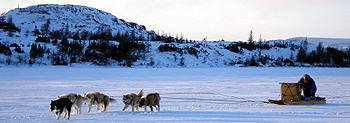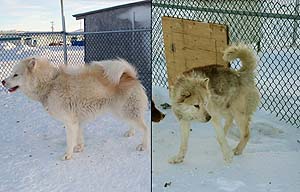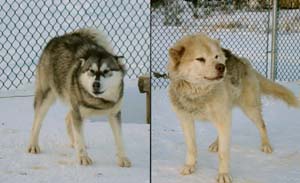In This Issue....
Featured Inuit Dog Owner: Sandy Hagan
Inuit Dog Thesis 15th Anniversary Edition
Product Review: Delivering the Goods
IMHO: A Few Thoughts about the Final Report on the Dog Slaughters
Navigating
This Site
Index of articles by subject
Index
of back issues by volume number
Search The
Fan Hitch
Articles
to download and print
Ordering
Ken MacRury's Thesis
Our
comprehensive list of resources
Talk
to The
Fan Hitch
The Fan
Hitch home page
ISDI
home page
Editor's/Publisher's Statement
Editor: Sue Hamilton
Webmaster: Mark Hamilton
The Fan Hitch welcomes your letters, stories, comments and suggestions. The editorial staff reserves the right to edit submissions used for publication.
Contents of The Fan Hitch are protected by international copyright laws. No photo, drawing or text may be reproduced in any form without written consent. Webmasters please note: written consent is necessary before linking this site to yours! Please forward requests to Sue Hamilton, 55 Town Line Rd., Harwinton, Connecticut 06791, USA or mail@thefanhitch.org.
This site is dedicated to the Inuit Dog as well as related Inuit culture and traditions. It is also home to The Fan Hitch, Journal of the Inuit Sled Dog.

Mark Brazeau taking his team out for a run Photo: Nancy Etok
Defining the Inuit Dog
by Mark Brazeau
Kangiqsualujjuaq, Nunavik, Canada
Some dog breeds such as the Labrador Retriever or St. Bernard are easy to identify. These breeds, as well as many others, possess very clear physical traits that define and separate them from others. Of course, within all breeds there are variations in size, colour, etc. Nonetheless, when presented with a Labrador Retriever, regardless of the individual colour and size, there is rarely any doubt that in fact it is a Labrador Retriever.
The Inuit Sled Dog is much more difficult to define. Even when consulting reliable resources such as Ken MacRury's thesis (The Inuit Dog: Its Provenance, Environment and History) or Geneviève Montcombroux's book (The Canadian Inuit Dog: Canada's Heritage), there seems to be a huge variety of colours, markings, fur types, body structures, etc. There is even debate among Inuit Dog enthusiasts as to what physical characteristics best define the Inuit Dog. Some individuals identify Canadian Inuit Dogs and Greenland Dogs as one breed, while others totally and wholeheartedly disagree.
Perhaps the most reliable assurance of purity is the documentation of ancestry via databases at ISDI or the CKC. But those databases are only as reliable as the breeders who register their dogs, and some do not. Even among all those registered Inuit Dogs, enough variances exist to trigger some uncertainty when visually identifying the dogs.
All of these uncertainties create problems for Qimmiit Utirtut. In attempting to revive the pure Inuit Sled Dog, we first need to be sure of what a pure Inuit Sled Dog actually is. We have examined historical photos of dogs and found there were inconsistencies. We carefully watched Inuit Dogs depicted in films and saw there were differences. We felt that we desperately needed to consult with some experts on Inuit Dogs to help us sort out the variances and to assure us that we were starting with sound breeding stock. Although it was not immediately obvious to us, the experts we needed were living among us in the community: the Inuit Elders.
Tivi Etok enjoying a mug up during the
interview
Photo:
Brazeau
We interviewed two prominent Elders in our community: Johnny-George Annanack (age 83) and Tivi Etok (age 78). Both are old enough and experienced enough to be considered experts on the Inuit Dog. We spent close to two hours with each of the men. We discussed the physical aspects of the dogs as well as their temperament and behaviour. After the interviews, we took both men outside to inspect our pure Inuit Dogs and get their opinion.
In discussing the physical characteristics of the Qimmituinnaq (pure Inuit Dog), Johnny-George and Tivi confirmed most of what we had read or observed, including the variances.
The coat colours and markings on the dogs varied a lot. Tivi explained that,
"The colours varied. Even siblings didn't have the same colours. There were dogs that were grey, brown, white, black. Some had black spots, like seals. The colours of the coats were all different. Some were beautiful dogs that had fur like wolves."The quality of the coat and build of the body also varied between dogs. Yet, variances in coat and body build seemed to depend more on nutrition than genetics. Both Tivi and Johnny-George explained how essential it was to ensure the dogs were properly nourished. Tivi shared the following:
"Back in the old days, all Inuit had dogs. The Inuit and their dogs survived on food from the land. Sometimes, when there was not much food to eat, our dogs would suffer and not grow properly. Some pure dogs were not good because they were so undernourished that they did not even look like Inuit Dogs. Dogs that ate well as they were growing into adults became beautiful strong dogs. Those dogs had very pointy fur. Dogs with straight pointy fur were very strong dogs."
Silarnik showing pointy fur Photo: Brazeau
Johnny-George went on to explain the importance of seal fat in the diet of the Inuit dog.
"The dogs needed to eat seal fat. It was good that the dogs had meat to eat, but they really needed seal fat. They craved the seal fat. If a dog was only fed on meat, it would lose its appetite until it was fed some seal fat."However, even if the dogs were equally well nourished there were still variances in their coat and build. Tivi explained that,
"The size of the body depended on the amount and type of food the dog ate. But sometimes dogs that were fed well did not grow big. Sometimes, well-fed dogs had short legs.Both Johnny-George and Tivi confirmed that all pure dogs had tails that curled up over their backs when they were pleased. Tivi explained that the amount of curl on the tail, the length of the tail, and the fur on the tail also varied.Sometimes dogs even had fur that would touch the ground. Those dogs that were really furry would get their fur tangled often, even in the ropes. The dogs with long wavy fur were not good dogs. The best dogs were the ones with the straight pointy fur."
"The tails were different for the dogs. Some were longer than others. Some were very furry. Some were shorter. Some curled more than others. Some tails curled so much that the tail rested on the back of the dog. Some tails curled less and just touched the back of the dog. The dogs curled their tail up over their backs when they were happy."

| Mirqulak has a very curly tail | Larry’s tail is less curly than some of the other dogs Photos: Brazeau |
There were far fewer differences between dogs when we discussed ears and eyes. Both men agreed that although there were differences in the lengths of the ears, some shorter and some slightly longer, all the ears were pointy, in a slightly forward direction. They went on to explain that many of the current dogs in Kangiqsualujjuaq are clearly mixed because they have longer ears that fold down at the side. Some mixed dogs also have one or two blue or white eyes. Inuit dogs from the past did not have blue or white eyes. It was a trait that the elders only observed later after the breed had been contaminated.
One interesting point about the physical characteristics had to do with the pads of the paws. While Tivi believes that pink and black pads are equally good, Johnny-George strongly believes that black pads are more durable on the rough snow in the spring. He said that,
"Dogs who had black paws were tougher. The black paws didn't get cut as easily in the spring as the light coloured paws. When the paws would get cut or dried and cracked, we would rub them with oil from the seal fat."The majority of our discussions with the Elders ultimately led to stories of how strong the dogs used to be and how important they were for survival. Even when we truly tried to focus on the physical characteristics of the Inuit dog, it was very apparent that the physical characteristics were of much less importance than temperament, behaviour and performance. The Inuit are very practical people—their survival depended on it. If they had a pink dog with curly fur and green eyes that could do the job required of them, the dog was highly valued. It is true that physical characteristics often reflect the fitness of the dog, but the physical characteristics were not the primary factors that determined whether a dog was valuable. First and foremost, the Inuit Dog had to be a good puller that was strong, with superior endurance. Johnny-George shared a story.
"When I was young, my father and I went caribou hunting. My father had ten dogs, but one stayed at the camp to protect the others. We went far to hunt caribou. In all, we got eleven caribou. My father and I cut up the caribou meat and piled it carefully on the qamutik so it would not fall. We had traveled all day and it was night when we got back to camp. Our dogs pulled all the meat and my father and me. The dogs were tired, but they did not stop pulling until we told them to. As we got closer to camp, they even went faster because they knew we were almost home."Tivi discussed how the mixed dogs nowadays are different from the dogs in the past with regard to their pulling strategy and work ethic.
"Back then, the best dogs started very slowly. Nowadays, dogs that pull start off running so fast. These dogs would never have beaten the dogs of the old days. The real good dogs would catch up to the fast starters and would continue on long after the other dogs stopped. The older Inuit people are like that too. When I was young, my father used to walk slowly and I thought he walked too slowly. By later in the day, I would become tired and could not keep up with him. I would even cry because I was so tired, but my father could keep going."It was also very important that the dogs listened well to their owner. Because the Inuit interacted with their dogs every day, the dogs were very obedient and followed instructions well. Sometimes, it was not necessary to give instructions. Tivi explained that,
"The good dogs were called Qimmisiaks. The good dogs, if they were taught well, listened very well. When they were told to turn they turned, and when they were told to stop they stopped. In a blizzard you did not have to tell them where to go, because they knew the way back to camp. The dogs could get you home in a blizzard if you didn't say anything to them and got yourself lost."Good dogs did not need to be trained to assist with hunting. It was something that came very naturally. It was also very natural for the dogs to keep on a safe path away from dangerously thin ice. Johnny-George stated,
"If a dog was well nourished and strong, it could go very far to look for food. Even if the food was under the ice or snow, the dog could smell it. Even if the caribou were very far, the dogs could smell them. They really knew how to find food. They kept their owners alive. Even when you walked with them on the sea ice, they would smell seals and look for holes. They would find a hole where the hunter could catch a seal.Despite its reputation for being aggressive and somewhat wild, the Inuit Dog could be socialized to interact very well with all adults, children and even strangers. Tivi shared the following:When you traveled in the spring, the dogs could sense the dangerous spots. They would spread out to smell around. Sometimes a dog would fall through the ice and get pulled out by the others. When this happened my father told me to go to the very end of the qamutik."
"Those dogs that were played with by children were very friendly with people. The boys would have the puppies wear harnesses and make them pull. The girls would pretend the puppies were babies and sometimes carry them in an amautik. Dogs who never played with children were more wild and had aggressive looking faces."

| Even though Ikalik is a Greenland Dog, Tivi and Johnny-George remembered dogs like her. She is an example of a dog with a narrower chest and shoulders | A pure ISD from John Laird in Iqaluit, Larry is an example of a dog with a broad chest and shoulders. Johnny-George said Larry is the best example of a dog from the past Photos: Brazeau |
Following our discussions on the physical, temperament and behaviour traits, both men were very excited to get outside to see the dogs. Both Tivi and Johnny-George were very impressed with how healthy and strong the dogs looked. It was obvious to them that the dogs were being well fed. There are no food shortages like in the past. Tivi commented several times on how the fur along the top of the back between the shoulders was good because it was straight and pointy—the way he remembered his best dogs. There were aspects of each dog that reminded both men of dogs in the past. They remembered dogs with very curly tails, like Mirqulaq's, and tails that were less curled, like Larry's. Some dogs were very broad in the shoulders like Larry and Saunik, others had narrower shoulders like Ikalik. Tivi was mostly taken by Piuna because she reminded him of one of the best females he ever had—the coloring, markings and size were just right.
Johnny-George Annanack was very
impressed with
Piuna (from Linda
Fredericksen)
Photo: Brazeau
At one point we posed a small challenge to Tivi. When we approached a group of eight dogs that were staked out, we asked Tivi to point out which dogs reminded him of dogs from the past. He was unaware that only three of the eight dogs were pure dogs. Without hesitation, Tivi correctly identified, "Those two black ones and the brownish white one on the end."
Ultimately, both Johnny-George and Tivi gave all of our Inuit Sled Dogs a good recommendation. Regardless, I could sense that their recommendation was conditional. Our dogs could only be considered good, true Inuit Dogs if they pull slowly, but steadily and hard all day long. If they were good dogs, they should be able to find seal holes, smell caribou at a distance, and take on polar bears. If our dogs were true Inuit Dogs, they should be able to get us home safely in a blizzard without being told where to go. Like a rusty old rifle that so many Inuit hunters use to shoot great distances with precise accuracy, the Inuit Dog is valued less by how it looks, and more by how it performs.
* * *
A very special thanks to Tivi Etok, Johnny-George Annanack, and Nancy Etok (translator) for their assistance with this story.